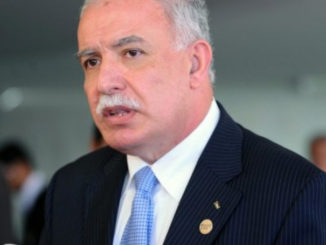
By Ilan Pappe – The Palestine Chronicle 
On this 55th anniversary of the June 1967 war, it is worthwhile to refute, once more, the fabrications and myths surrounding this war that helped to immunize Israel until today from any meaningful international rebuke and condemnation.
One myth that quite a few liberal Zionists and even genuine supporters of the two-state solution believe in, is that the June 1967 war was the mother of all evils. Namely, they assert that until 1967, Israel was a peaceful democracy, defending itself in an alien neighborhood, a social democracy paragon, if there ever was one.
This is the mantra of the Zionist Left that ignores the leading role its brand of Zionism played in the 1948 ethnic cleansing of Palestine. It disregards the harsh and inhumane military rule that Labour-led Israel imposed on the Palestinians remaining within the Jewish State until 1967. A period in which Israel continued the ethnic cleansing of a dozen more Palestinian villages. The same cruel scenes of the brutal military occupation in the West Bank, which moved so many in the world to side with the Palestinians, were already visible in the 1950s inside Israel itself.
This benign image of a small Israel that became, through no fault by itself, a mini-empire and an occupier, also ignores the 1956 Suez fiasco, when Israel colluded with Britain and France in an abortive imperialist attempt to topple Gamal Abdul Nasser.
The provocative Israeli policy on the Syrian border, the Israeli diversion of the Jordan River, and the overt threats of its leaders to topple the Syrian regime are also somehow forgotten. An aggressive policy in the north led Nasser to believe genuinely that an Israeli attack on Syria would be more substantial than the ones Israel carried out in the Gaza Strip and the West Bank.
Full knowledge of Israel’s intransigence does not only debunk the myth of the small and peaceful Israel, it also helps to understand better the trajectory that led to the outbreak of the June 1967 war. The main Arab player, Gamal Abdul Nasser, was clearly moved by a genuine wish to help the liberation of Palestine, on the one hand, and by his own personal search for pan-Arab glory, on the other. For that he did not need a war; he just had to show that he was willing to go to war.
A huge success for him would have been a willingness of the UN to reconsider its disastrous 1947 “peace plan” that enabled the 1948 ethnic cleansing of Palestine. In order to achieve this, he pursued a brinkmanship policy, which was careless at times, as it provided Israel with the pretext to complete the takeover of Palestine which it had not managed to do in 1948.
Ever since 1948, a sizeable number of the Israeli generals who took part in the ethnic cleansing of Palestine created a lobby pressuring the Israeli government to occupy the West Bank, which they regarded as both the heart of the nation and a buffer zone from any attack on the Jewish state from the east.
Had it not been for David Ben-Gurion, the architect of the 1948 ethnic cleansing, this kind of operation might have taken place before 1967. He was the most powerful politician in Israel until 1963, and he did not wish to incorporate a large number of Palestinians after he successfully expelled almost all of those living in what became Israel. Nonetheless, such an occupation nearly occurred in 1960, when Nasser signaled that he would not tolerate the continued Israeli encroachment of the Jordan River estuaries and violate the no man’s zone separating Israel from Syria (he was then the leader of the United Arab Republic, which lasted as a political union between Egypt and Syria until 1961).
In 1960, very much like in 1967, Nasser despatched the Egyptian army to the Sinai Peninsula, closed the Tiran Straits at the entrance to the Gulf of Aqaba, but this did not lead to war as Ben-Gurion curbed his General’s war mongering. Israel backed off from its aggressive policies for a while (also because the Eisenhower and Kennedy administrations were still able to pursue a more reserved policy towards Israel before AIPAC became a force to reckon with, and tilted American policy onto its familiar pro-Israeli orientation ever since).
Ben Gurion knew too well that Nasser, unlike for instance the more conservative regimes in the region, was committed on a moral level to the liberation of Palestine or, at least, as he so often stated, to the return of the refugees and to the Israeli withdrawal from the territories allocated in 1947 by the UN to the Palestinians (a position based on international law according to the West, but when aired by Nasser was regarded as “Arab radicalism”). Unlike Ben-Gurion, Moshe Sharett (Prime Minister in 1954-1955) was willing to begin negotiation with Nasser on the basis of these principles, a move thwarted the moment Ben-Gurion came to power, determined to bring down Nasser and the Baath in Syria.
For a while, it seemed that Nasser was successful. The US led an international initiative to re-open negotiations on the future of post-mandatory Palestine. Israel could not allow it and began its war on 5 June 1967. The bewildered British delegation in the UN wrote to the Americans:
“We have now examined that evidence [and] have come to the conclusion that the Israelis fired the first shot and take the view that it was reprehensible of them not [to] wait for the efforts we and others were making to extricate them from the admittedly impossible situation in which the UAR had placed them.”
This was one of the many exit points from the crisis. Nasser managed, in a way, to force the international community to realize that the Palestine case and cause were not over in 1948. What he and many others in the international community did not realize was that, with brinkmanship policy or without it, the Israeli leadership since 1963, when Ben Gurion was ousted from any meaningful role in it, prepared for the occupation of the West Bank and the Gaza Strip and would have carried it out, sooner or later.
As a settler-colonial state, getting more territory was a superior priority than getting rid of the native population – the method was the same for all settler colonial movements: once you rob the indigenous population of its homeland, you can begin to deal with the indigenous people living on it (Israel did the same in the Golan Heights in 1967 – after occupation, it ethnically cleansed more the 100,000 of the local population).
The plans for occupation and how to run the 22% of Palestine (the West Bank and the Gaza Strip) Israel failed, or decided not, to occupy in 1948, were already set in 1963. The basic idea was simple: a ready-made military rule was already active in the Palestinian areas within the state of Israel; all that had to be done was to move swiftly and impose it on the West Bank and the Gaza Strip in 1967.
When the military occupation was completed, and the new military rule instated, the 13th government of Israel took a strategic decision, which none of the successive Israeli governments deviated from. The West Bank will be forever part of Israel and, with time, the Jewish state will do all it can to downsize the number of Palestinians living there (enclaving Gaza was already then considered a serious option, as a complementary part of the plan).
There were tactical debates about which parts of the West Bank had to be officially annexed (apart from a consensus on the annexation of East Jerusalem) and how to present this expansionist plan, the second phase of the 1948 ethnic cleansing operations, to the world. There and then, “the peace process” was inverted, later presented even as a two-state solution (namely whichever part Israel was willing to rule indirectly could be autonomously run by the Palestinians). The world and, alas, quite a few Palestinians, bought into yet another Zionist fabrication and manipulation of the truth.
The more Israel moved to the right, the more it shrunk the “autonomy”. With the risk of prediction, I venture that this diminution of “autonomous” Palestinian presence in the West Bank (around 15% right now of the West Bank, namely less than 4% of historical Palestine) would eventually lead to the dismantling by Israel of the PA or its transformation into a mere municipality of greater Ramallah. This process has already begun.
It incurs good news. As Amnesty International, a bit too little and too late, is willing to frame this reality as a state of Apartheid, this future aggressive policy will recruit many more in the West to accept Amnesty’s interpretation, and perhaps even the more accurate one offered by the Palestinian civil society and activists (a more direct reference, without any caveats, to the apartheid reality). This may put the last nail in the two states coffin, undermine the logic of the Abraham Accord and force official Palestinian leadership to return to the one-state solution as a vision and strategy.
I know this still sounds utopian and its realization depends also on Palestinian unity and strategic organization. But it will be an important part of a possible liberation in the future. Moshe Dayan told the 13th government of Israel that the people of the occupied West Bank and Gaza Strip would be citizen-less citizens – people with no rights at all to discuss their fate and future. “For how long” will it be, he was asked by the leader of Herut, later the Likud, Menachem Begin. “Oh, at least for 50 years”.
It is now 55 years of the inhumane monstrous prisons Israel built and maintained in the West Bank and the Gaza Strip. They survived two brave uprisings but will encounter a third one, which is looming in the very near future. And with it, hopefully, the fabricated narrative which accompanied the second phase of the Israeli ethnic cleansing in 1967 will expose the real nature of liberal Zionism, put an end to all sorts of “peace camps”, and sober up religious believers in the two states solution – among them some of our best friends, and challenge anyone who claims that Palestine is lost.

– Ilan Pappé is a professor at the University of Exeter. He was formerly a senior lecturer in political science at the University of Haifa. He is the author of The Ethnic Cleansing of Palestine, The Modern Middle East, A History of Modern Palestine: One Land, Two Peoples, and Ten Myths about Israel. He is the co-editor, with Ramzy Baroud of ‘Our Vision for Liberation.’ Pappé is described as one of Israel’s ‘New Historians’ who, since the release of pertinent British and Israeli government documents in the early 1980s, have been rewriting the history of Israel’s creation in 1948. He contributed this article to The Palestine Chronicle.







